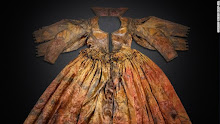In celebration of the upcoming royal wedding, I’ve
just begun a limited-edition weekly column, “Why Royal Weddings Matter,” on Confluence Daily, an online magazine especially for women.
The first post, “The Real Fairy Tale,”
has excerpted bits from both The End of
the Fairy-Tale Bride (available on Amazon) and my book in progress, A Memory of Beauty: The Spiritual
Mission of a Princess.
I've reprinted the article below with some yummy wedding photos. Enjoy!
.................................................................
The Real Fairy Tale
With splendid
pageantry and elegant costumes, royal weddings bring up “fairy-tale” dreams of
love and romance. “Fairy,” an English word, comes from the French fée, which came from the Latin fatare, “to enchant.” No wonder royal
weddings and “enchantment” go hand-in-hand—especially when there is an engaging
tug-of-the-heart story with the charms of Prince Harry and Meghan Markle.
Following in his
brother Prince William’s footsteps, Harry not only will marry the woman he
loves this spring, but his spiritual partner as well. Only a generation
before—in the arranged marriage code-of-conduct royal world—such a “love first,
duty second, woman with a past” arrangement for any heir to the British throne
would have been, if not impossible, certainly one with consequences.

William and Harry’s
parents’ wedding in 1981 stirred the hope of “fairy tale” and yet, as Diana and
Charles’ marriage played out, any notion of “happily ever after” soon vanished.
Theirs was an arranged marriage that pretended it was not. Although times were
changing when they married, the social culture had not shifted enough to allow
Prince Charles to follow his true feelings. Perhaps even more consequential,
the Windsor family was shadowed by kinsman King Edward VIII who in 1936, with
some political pressures, gave up the throne “for the woman he loved.” The
scandal was a little too close in historical proximity for Charles to make a
similar decision about marrying someone for love who didn’t fit the “queenly
model.”

Nonetheless,
almost seven decades after King Edward’s abdication, cultural changes were on
Prince Charles’ side—thanks in great part, ironically, to his late wife
insisting on bringing more heart into
the royal family. In 2005, 24 years after his marriage of “dynastic duty” to
Diana, Charles did not have to give up the throne nor start a palace revolt,
yet, with his queen’s blessing, he indeed married the woman who had been his
longtime friend and confidante—the woman he had long loved.
In
this more modern and egalitarian grand gesture, Charles and Camilla’s marriage
put the seal on “love over duty,” supporting Edward’s heartful claim that “he
could be a better king with the woman he loved at his side.” With such a
legacy, when it was time for Charles’ sons to marry, they fell in love with
women who matched their vision and compassion—beautiful “commoners” with
“backgrounds” no less!
So call royal weddings “fairy tales” if you must, but the conscious
connection that both Princes William and Harry have made in their marriage
choices is simply what I call the way life is meant to be when heads are clear
and hearts are strong. Whether king or prince or commoner, “what your heart thinks is great, is great,”
poet Ralph Waldo Emerson wrote. “The soul’s emphasis is always right.” ~






































